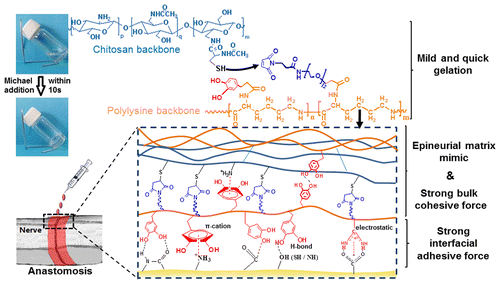当前位置:
X-MOL 学术
›
Biomacromolecules
›
论文详情
Our official English website, www.x-mol.net, welcomes your
feedback! (Note: you will need to create a separate account there.)
Rapid Gelling Chitosan/Polylysine Hydrogel with Enhanced Bulk Cohesive and Interfacial Adhesive Force: Mimicking Features of Epineurial Matrix for Peripheral Nerve Anastomosis
Biomacromolecules ( IF 5.5 ) Pub Date : 2016-01-27 00:00:00 , DOI: 10.1021/acs.biomac.5b01550
Yalin Zhou 1 , Jin Zhao 1 , Xiaolei Sun 2 , Sidi Li 1 , Xin Hou 1 , Xubo Yuan 1 , Xiaoyan Yuan 1
Biomacromolecules ( IF 5.5 ) Pub Date : 2016-01-27 00:00:00 , DOI: 10.1021/acs.biomac.5b01550
Yalin Zhou 1 , Jin Zhao 1 , Xiaolei Sun 2 , Sidi Li 1 , Xin Hou 1 , Xubo Yuan 1 , Xiaoyan Yuan 1
Affiliation

|
Prompt and strong reconnection of severed peripheral nerves is crucial to nerve regeneration. The development of biocompatible nerve adhesives that are stronger than commonly used fibrin glue would be extremely beneficial to this field. We designed an in situ forming nerve adhesive hydrogel composed of chitosan and ε-polylysine (PL), which mimics the polysaccharides/protein structure of natural epineurium matrices, thus, enhancing the compatibility with nerves. Michael-type addition between the maleimide and thiol group was employed as a cross-linking reaction to eliminate foreign damage to nerves and to ensure a fast hydrogel formation speed (curing speed). Gelation occurred within 10 s, quick enough to promptly seal the transected nerve. Catechol groups conjugated onto PL molecules were demonstrated to reinforce both the bulk cohesive force of the hydrogel and the interfacial adhesive force between the hydrogel and epineurium. The storage modulus of the hydrogel was elevated to more than 2400 Pa. A superior nerve adhesion property that can tolerate 0.185 N of force (8× higher than fibrin glue) was obtained. After 8 weeks, the morphology of the repaired nerve fiber coapted by our hydrogel was very close to the morphology of normal nerve, and the axon cross ratio of the regenerated nerves coapted using hydrogel (57%) was much higher than employing the suture technique (35%). Thus, the in situ rapid gelling system offers a promising approach to the repair of severed peripheral nerves.
中文翻译:

快速胶凝壳聚糖/聚赖氨酸水凝胶具有增强的整体内聚力和界面粘合力:模仿神经周围神经吻合的肾上腺基质的特征。
迅速而牢固地重新连接切断的周围神经对于神经再生至关重要。比一般的纤维蛋白胶更坚固的生物相容性神经胶粘剂的开发将对该领域极为有益。我们设计了一种由壳聚糖和ε-聚赖氨酸(PL)组成的原位形成神经粘附水凝胶,该凝胶模仿了天然神经外膜基质的多糖/蛋白质结构,从而增强了与神经的相容性。马来酰亚胺和硫醇基之间的迈克尔型加成被用作交联反应,以消除外来的神经损伤并确保快速的水凝胶形成速度(固化速度)。凝胶化发生在10 s内,足够快以迅速密封横断的神经。已证明缀合到PL分子上的邻苯二酚基团既增强了水凝胶的整体内聚力,又增强了水凝胶与神经外膜之间的界面粘合力。水凝胶的储能模量提高到2400 Pa以上。获得了优异的神经粘附性能,可以承受0.185 N的力(比纤维蛋白胶高8倍)。8周后,我们的水凝胶接合的修复神经纤维的形态非常接近正常神经的形态,而水凝胶接合的再生神经的轴突交叉比(57%)远高于缝合技术( 35%)。因此,原位快速胶凝系统为修复切断的周围神经提供了一种有前途的方法。水凝胶的储能模量提高到2400 Pa以上。获得了可耐受0.185 N力(比纤维蛋白胶高8倍)的优越的神经粘附特性。8周后,我们的水凝胶接合的修复神经纤维的形态非常接近正常神经的形态,而水凝胶接合的再生神经的轴突交叉比(57%)远高于缝合技术( 35%)。因此,原位快速胶凝系统为修复切断的周围神经提供了一种有前途的方法。水凝胶的储能模量提高到2400 Pa以上。获得了可耐受0.185 N力(比纤维蛋白胶高8倍)的优越的神经粘附特性。8周后,我们的水凝胶接合的修复神经纤维的形态非常接近正常神经的形态,而水凝胶接合的再生神经的轴突交叉比(57%)远高于缝合技术( 35%)。因此,原位快速胶凝系统为修复切断的周围神经提供了一种有前途的方法。我们的水凝胶结合的修复神经纤维的形态非常接近正常神经的形态,水凝胶结合的再生神经的轴突交叉比(57%)远高于缝合技术(35%)。因此,原位快速胶凝系统为修复切断的周围神经提供了一种有前途的方法。我们的水凝胶结合的修复神经纤维的形态非常接近正常神经的形态,水凝胶结合的再生神经的轴突交叉比(57%)远高于缝合技术(35%)。因此,原位快速胶凝系统为修复切断的周围神经提供了一种有前途的方法。
更新日期:2016-01-27
中文翻译:

快速胶凝壳聚糖/聚赖氨酸水凝胶具有增强的整体内聚力和界面粘合力:模仿神经周围神经吻合的肾上腺基质的特征。
迅速而牢固地重新连接切断的周围神经对于神经再生至关重要。比一般的纤维蛋白胶更坚固的生物相容性神经胶粘剂的开发将对该领域极为有益。我们设计了一种由壳聚糖和ε-聚赖氨酸(PL)组成的原位形成神经粘附水凝胶,该凝胶模仿了天然神经外膜基质的多糖/蛋白质结构,从而增强了与神经的相容性。马来酰亚胺和硫醇基之间的迈克尔型加成被用作交联反应,以消除外来的神经损伤并确保快速的水凝胶形成速度(固化速度)。凝胶化发生在10 s内,足够快以迅速密封横断的神经。已证明缀合到PL分子上的邻苯二酚基团既增强了水凝胶的整体内聚力,又增强了水凝胶与神经外膜之间的界面粘合力。水凝胶的储能模量提高到2400 Pa以上。获得了优异的神经粘附性能,可以承受0.185 N的力(比纤维蛋白胶高8倍)。8周后,我们的水凝胶接合的修复神经纤维的形态非常接近正常神经的形态,而水凝胶接合的再生神经的轴突交叉比(57%)远高于缝合技术( 35%)。因此,原位快速胶凝系统为修复切断的周围神经提供了一种有前途的方法。水凝胶的储能模量提高到2400 Pa以上。获得了可耐受0.185 N力(比纤维蛋白胶高8倍)的优越的神经粘附特性。8周后,我们的水凝胶接合的修复神经纤维的形态非常接近正常神经的形态,而水凝胶接合的再生神经的轴突交叉比(57%)远高于缝合技术( 35%)。因此,原位快速胶凝系统为修复切断的周围神经提供了一种有前途的方法。水凝胶的储能模量提高到2400 Pa以上。获得了可耐受0.185 N力(比纤维蛋白胶高8倍)的优越的神经粘附特性。8周后,我们的水凝胶接合的修复神经纤维的形态非常接近正常神经的形态,而水凝胶接合的再生神经的轴突交叉比(57%)远高于缝合技术( 35%)。因此,原位快速胶凝系统为修复切断的周围神经提供了一种有前途的方法。我们的水凝胶结合的修复神经纤维的形态非常接近正常神经的形态,水凝胶结合的再生神经的轴突交叉比(57%)远高于缝合技术(35%)。因此,原位快速胶凝系统为修复切断的周围神经提供了一种有前途的方法。我们的水凝胶结合的修复神经纤维的形态非常接近正常神经的形态,水凝胶结合的再生神经的轴突交叉比(57%)远高于缝合技术(35%)。因此,原位快速胶凝系统为修复切断的周围神经提供了一种有前途的方法。

































 京公网安备 11010802027423号
京公网安备 11010802027423号